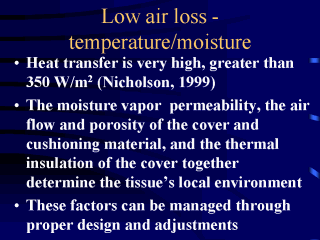 |
As with other
fluid-filled surfaces, the temperature of the skin is affected by the specific heat of the
fluid material and air does not have a high specific heat. In addition, the circulating
air is warmed. However, the constant air circulation and evaporation tend to keep the skin
from overheating. Nicholson showed that heat transfer on a low air loss mattress was
greater than 350 W/square m (Nicholson, 1999). In low air loss systems, the patient's
skin is in contact with the cover. The local tissue environment is a function of the
moisture vapor permeability of the cover and cushion materials, the air flow and porosity
of the cover and cushion materials, and the thermal insulation of the cover. The ideal
combination of these factors would be a material with a high thermal insulation to prevent
excessive loss of body heat, a high moisture vapor permeability to prevent accumulation of
excess moisture on the skin, and a moderate airflow to keep the skin from overheating. In
a study by Flam, low air loss cover materials were rated based on a normalized comparison
of these parameters . The combination of a cover made from nylon/high air loss Gore-Tex
(R) laminate material and a cushion made from nylon/high air loss Gore-Tex (R)
laminate material had the highest scores and were most likely to promote a favorable local
climate at the skin-cover interface . Low air loss devices have been shown to prevent
build-up of moisture and subsequent skin maceration . |
